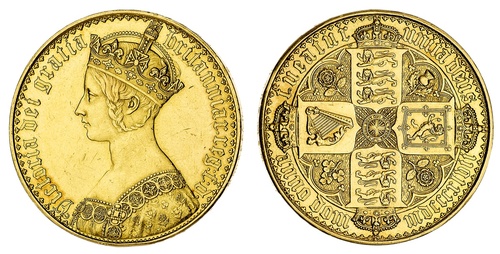
Auction: 24006 - British and World Coins
Lot: 389
(x) An Infamous Counterfeit Gold 'Gothic' Crown [struck in 1973 in 21.6ct Gold], in the style of William Wyon's Iconic 1847 UNDECIMO Pattern for Queen Victoria, Unofficial "Mint" in Beirut, VICTORIA DEI GRATIA BRITANNIAR. REG: F. D., in gothic lettering, crowned 'Gothic' bust left, WW on truncation, rev. TUEATUR UNITA DEUS || ANNO DOM MDCCCXLVII in gothic lettering, crowned shields cruciform, national floral emblems in angles, lettered edge: decus |* et * tutamen *| anno * regni *| undecimo * downwards, [Spink XRF ~90.42% Gold; ~7.97% Copper; ~1.61% Silver], 49.87g, 6h (SCMB Vol. 701, January 1977, pp. 13-14; ISBCC, Bulletin on Counterfeits, No. 1), small surface dents and marks, in otherwise brilliant and reminiscently proof-like fields, a highly sophisticated and extraordinarily faithful fabrication concocted at the height of the '1970s Coin Market Boom', about extremely fine, ungradeable but of undeniable artistic merit and immense novelty as a 'coffee table piece' and gap filler for the prohibitively expensive and unobtainable original last seen at the Spink-Taisei auction of 1988
Counterfeits, Concoctions, Fantasies and Restrikes are all subject matters that make the numismatic purist despair. If an official coin has a collector's value, there becomes an ever greater incentive amongst the unscrupulous to produce forgeries, deceptive or otherwise. To subsequently 'legitimise' these unofficial or fraudulent products is an understandably precarious line to tread. Yet it is one that has been navigated by our forebears on many an unfortunate occasion. Most famous cases over the centuries include the Paduan imitations of the 16th Century, before the scourge of Edward Emery in the early 19th Century and more recently Trevor Ashmore. Whilst the former have become collectables in their own right, it is only in more recent times that Ashmore fabrications in their distinctive crude style have appeared at auction as 'academic' curiosities.
More scurrilous concoctions have been spotted but not attributed such as the 'Haslemere forger' of Iron age series and 'the master Beirut forger', much like Ashmore, were products of the 1970s 'coin boom'. It is this latest case that affords us perhaps the most powerful reminder of a need for trade regulators such as that established by the British Numismatic Trade Association (founded 1973) and more recently by third-party grading companies (founded between 1986-1989).
The input and eyes of the BNTA ensured the conviction of seven men for a total of 20 years at Manchester Crown Court in November 1976. Contemporary Seaby Bulletins documented the list of proclaimed gold forgeries from George II to George V as well fabrications in silver of the Gothic Crown and 1905 Halfcrown. Whilst this list covers a multitude of common and key date issues, the appearance of both plain edge and lettered edge "Gold Proofs" of the Gothic Crown are of particular significance, given the excessive rarity of the official issue in this metal during Wyon's tenure at the Royal Mint. Only two true issues are known in gold, both superbly well documented since at least 1875, with one offered only seven years after the coin was first struck.
Notably the official strikings were struck with plain edges, and equally, like the officially produced Wyon Patterns, on medallic alignment. Non-invasive scientific testing conducted by Spink in January 2024 has corroborated an XRF gold signature of 21.6ct, below the tolerance of contemporary Victorian gold specie, and considerably below the fineness utilised by Wyon in his striking of contemporary gold Patterns and Proofs. Both visually and metallurgically therefore this concoction stands apart from the original, sufficiently differentiated to even the most cynical of coin connoisseurs. However, its faithful rendering, much like those officially restruck by the Royal Mint in 2022 is of frankly extraordinarily competent execution, and unlike those recent after-market productions presents the would-be winner with a truly exceptional coffee-table discussion piece without breaking the bank! It being noteworthy that the vast majority of these were destroyed as a result of the conviction, rendering this both an historic witness and artistic marvel in the style of Wyon's iconic masterpiece
Subject to 5% tax on Hammer Price in addition to 20% VAT on Buyer’s Premium.
Estimate
£15,000 to £20,000
Starting price
£15000




